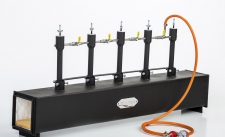Forging Oven





In the blacksmith and decorative ironwork shops, gas forges are quickly replacing coal. There are many reasons for this change. Coal is dirty in both smoke emissions, and the resulting ash and clinker that must be disposed of. On the other hand propane is portable, transported by train, truck, cart and by hand. This makes it available where gas pipe lines do not exist. Small blacksmith gas forges, now equipped with auto igniters, are easy to light and convenient to use. The cost of propane fuel is comprable to coal, with the advantage of less labor expense.
The horizontal forge is a popular configuration, due to the longer heat chamber, which simplifies the heat treating process somewhat for longer work pieces. With the angle of the burner entry port and the position of the workpiece in the forge chamber, this problem is minimized to a great degree.They are designed to suit particular applications, whether it’s horseshoeing, architectural design, artist blacksmithing, knife and sword making, glass bead making, furniture fabrication or melting ferrous metals.
The larger units are designed for either large or small volume use due to its flexibility. One or more rows of burners can be shut down when smaller parts are being heated at considerable fuel savings. The larger units are also equipped with a safety valve for user protection. If fuel is accidentally turned on, the safety valve will shut the fuel off, if no heat is detected. Thus, preventing any dumping of fuel into the work area.
View All Manufacturers